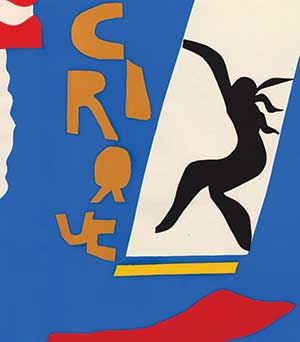

As the protective black tarp lifts from the glass cases before opening time at the Iris and B. Gerald Cantor Center for Visual Arts, the images of Henri Matisse (1869-1954) appear in front me. In the forms of jazz, clowns, nightmares, circuses, knife throwers, funerals and lagoons, these 20 spirited block-like representations occupy what looks like a secret room off one corridor.
Normally under wraps in the Gunst Collection in Special Collections at the Stanford University Library across campus, these original prints serve as evidence of a later period in Matisse’s life, when he was bedridden, convalescing from cancer and limited in his mobility. He could not work with brushes or pencils in the normal fashion. Originally published as Jazz, a book with his own text and explanations, the colorful prints depict a cross-pollination of free musical improvisation and visual art practice. The trademark Matisse vibrancy remains.
Book It
For these works, which might resemble silkscreens of elementary school construction paper projects to the more unimaginative observer, Matisse instructed his assistants to cover paper with glorious gouache colors so he could then attack the results by “painting with scissors.” The final collages were then printed into limited edition books and sets.
Although these prints are recognized throughout the universe, seeing them up close in person confirms a degree of joyous creativity on Matisse’s part. He did not let his physical disabilities impair his inventive spirit. The way I see it, the titles impart a whimsical celebration of the muse, inspired by the active cultures of circus and theater—Le Clown (The Clown), Le Cauchemar de l’Elephant Blanc (The Nightmare of the White Elephant), L’Enterrement de Pierrot (The Funeral of Pierrot) and L’Avaleur de Sabres (The Sword Swallower), to name but a twisted few.
As the high-spirited colors vibrate into my consciousness, I peruse a museum copy of the 1980s edition of the accompanying book, Jazz, while sitting on a puffy black bench in the middle of the room. Featuring a translation of the original French, the volume contains Matisse’s musings on life, love and happiness, almost jazzy in their presentation. “To cut to the quick in color,” he writes, “reminds me of the direct cutting of sculptors. This book was conceived in the same spirit.”
Jazz Visions
Even though Matisse, then in his seventies during World War II, still retained a quintessential French joie de vivre, it took two years to produce the final results. He refused to let the war drag him or his creativity down. At the time, Matisse even wrote that the context of jazz evoked for him a liveliness, a connection with the audience and a free-form celebration of the unexpected, borne from improvisation. Cut-ups, interruptions and even accidents became part of the process.
All of this is evident in this classic set of 20 jazz visions. And they are visions, not just prints or collages. The term “synesthesia” comes to mind upon viewing them in this little room. One can almost smell the music and taste the colors. It’s a vibrant, multi-sensory bouillabaisse, cooked up with Matisse’s own text supplying a viable counterpoint. He hand-wrote 16 pages of text and interspersed them between the images, but not solely to function as words. He explained that the large handwriting was intended to function visually as well, sort of like concrete poetry. As I sat there on the padded black bench, finishing the text, it concluded with exactly the type of musical passage one should contemplate when ingesting this set of prints:
JAZZ. These images, with their lively and violent tones, derive from crystallizations of memories of circuses, folk tales, and voyages. I’ve written these pages to mollify the simultaneous effects of my chromatic and rhythmic improvisations; pages forming a kind of ‘sonorous ground’ that supports them, enfolds them, and protects them, in their particularities.


